Medical Disclaimer:
This article is for informational purposes only and does not constitute veterinary advice. Always consult your veterinarian for a proper diagnosis and treatment plan tailored to your pet. Never delay or disregard professional advice based on online information.
Table of Contents
Introduction
If your dog constantly scratches their ears, licks their paws, or smells a bit… funky, you might be dealing with a yeast infection. I’ve seen countless cases like this in my Ottawa practice dogs miserable from itchy skin or recurring ear gunk, while their owners feel helpless. The good news? Dog yeast infections are common, treatable, and often preventable with the right approach.
This guide blends real-world veterinary experience with trusted research to help you recognize, treat, and prevent yeast overgrowth in dogs. Whether your dog’s symptoms are new or they’ve battled this before, you’ll find clear answers and relief below.
Key Takeaways: Dog Yeast Infections at a Glance
- Dog yeast infections often affect ears, paws, or skin folds, especially in warm, moist areas.
- The most common culprit is Malassezia pachydermatis, a yeast that normally lives on the skin but can overgrow.
- Signs include itchy, smelly skin, greasy fur, dark ear discharge, and excessive licking or scratching.
- Treatments include topical antifungals, medicated shampoos, and sometimes oral medications.
- Natural remedies like diluted apple cider vinegar or coconut oil may help, but should only be used under veterinary guidance.
- Preventing future infections means maintaining hygiene, adjusting diet, and managing allergies or underlying conditions.
- Always see your vet if symptoms worsen, persist beyond a week, or keep coming back.
What Are Dog Yeast Infections?
Also Visit: https://doglifeexpert.com/7-ways-to-ease-seasonal-allergies-in-dogs/

Dog yeast infections are caused by an overgrowth of naturally occurring yeast primarily Malassezia pachydermatis on a dog’s skin, ears, or paws. In healthy dogs, this yeast coexists peacefully with other microbes. But when the balance is disrupted, yeast can multiply and trigger inflammation, itching, and infection.
In my Ottawa clinic, I often see dogs with inflamed ears, greasy skin, or foul odours all classic signs of yeast overgrowth. These infections are especially common in breeds with skin folds (like Bulldogs or Shar-Peis), floppy ears (such as Cocker Spaniels), or a history of allergies.
According to research published in Frontiers in Cellular and Infection Microbiology, M. pachydermatis is the leading cause of yeast dermatitis in dogs, contributing significantly to otitis externa and skin irritation in pets with compromised skin barriers (Frontiers in Microbiology, 2020).
Veterinary dermatologists recognize dog yeast infections as a top differential diagnosis when dogs present with chronic itching, especially in moist areas. Recognizing and addressing yeast early prevents secondary infections and long-term skin damage.
Common Causes & Risk Factors of Dog Yeast Infections
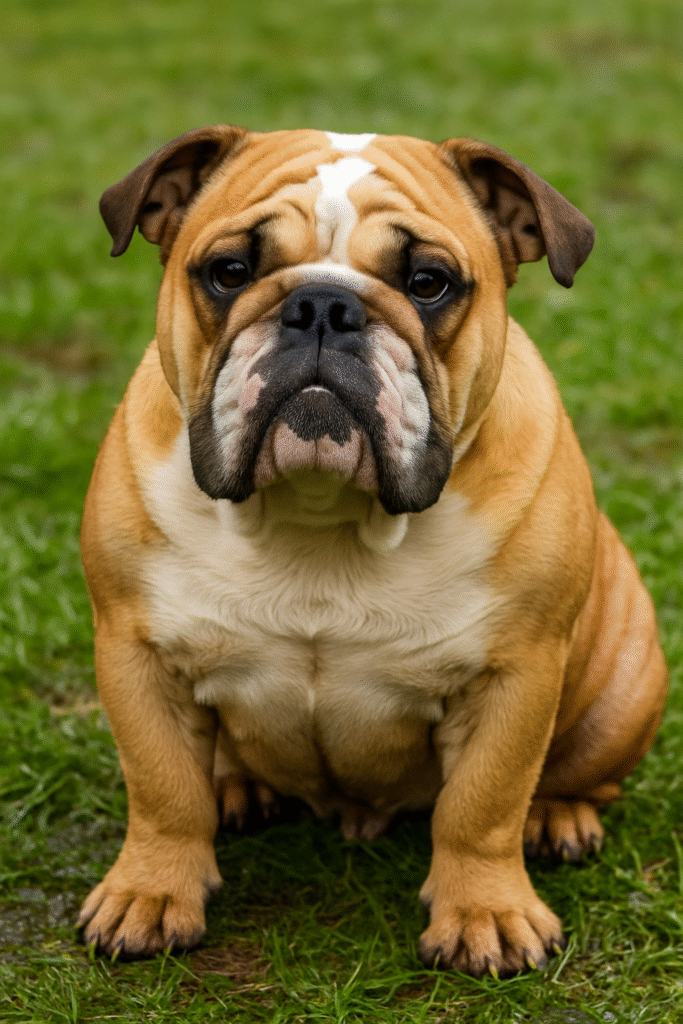
Yeast doesn’t just appear out of nowhere certain conditions create the perfect storm for overgrowth. Understanding these triggers helps you prevent and manage dog yeast infections more effectively.
1. Moisture & Humidity
Yeast thrives in warm, damp environments. Areas like the ears, groin, armpits, paws, and skin folds stay moist—especially in dogs that swim frequently or live in humid climates. I’ve treated many floppy-eared breeds (like Golden Retrievers) whose dog ear yeast infections flared after a summer of lakeside dips.
Keeping ears and folds dry, especially after bathing or swimming, is crucial in prevention.
2. Skin pH and Sebum Imbalance
Healthy skin maintains a mildly acidic pH and a balanced oil (sebum) layer, both of which discourage yeast overgrowth. But when that balance shifts due to skin damage, poor grooming, or certain shampoos yeast can proliferate.
According to dermatological studies, fluctuations in skin lipids and pH are strongly associated with Malassezia infections in dogs (PMC, 2017).
3. Antibiotic or Steroid Use
Medications like corticosteroids and broad-spectrum antibiotics, while helpful for many conditions, can suppress the immune system or kill off beneficial bacteria. This gives yeast a competitive advantage. In my own patients, I often see dog yeast infections emerge after extended antibiotic courses for unrelated issues like UTIs or dental infections.
4. Diet & Allergies
Food sensitivities or high-carbohydrate diets can disrupt the gut-skin microbiome axis, increasing the risk of yeast overgrowth in dogs. Dogs with chronic skin issues often improve after switching to hypoallergenic or low-glycemic diets. Research also links food allergies to secondary skin infections like yeast dermatitis (DVM360).
5. Underlying Health Conditions
Chronic illnesses such as hypothyroidism, Cushing’s disease, or immune suppression predispose dogs to recurrent canine yeast infections. Dogs with these conditions may require ongoing management and periodic yeast surveillance.
Signs & Symptoms of Dog Yeast Infections
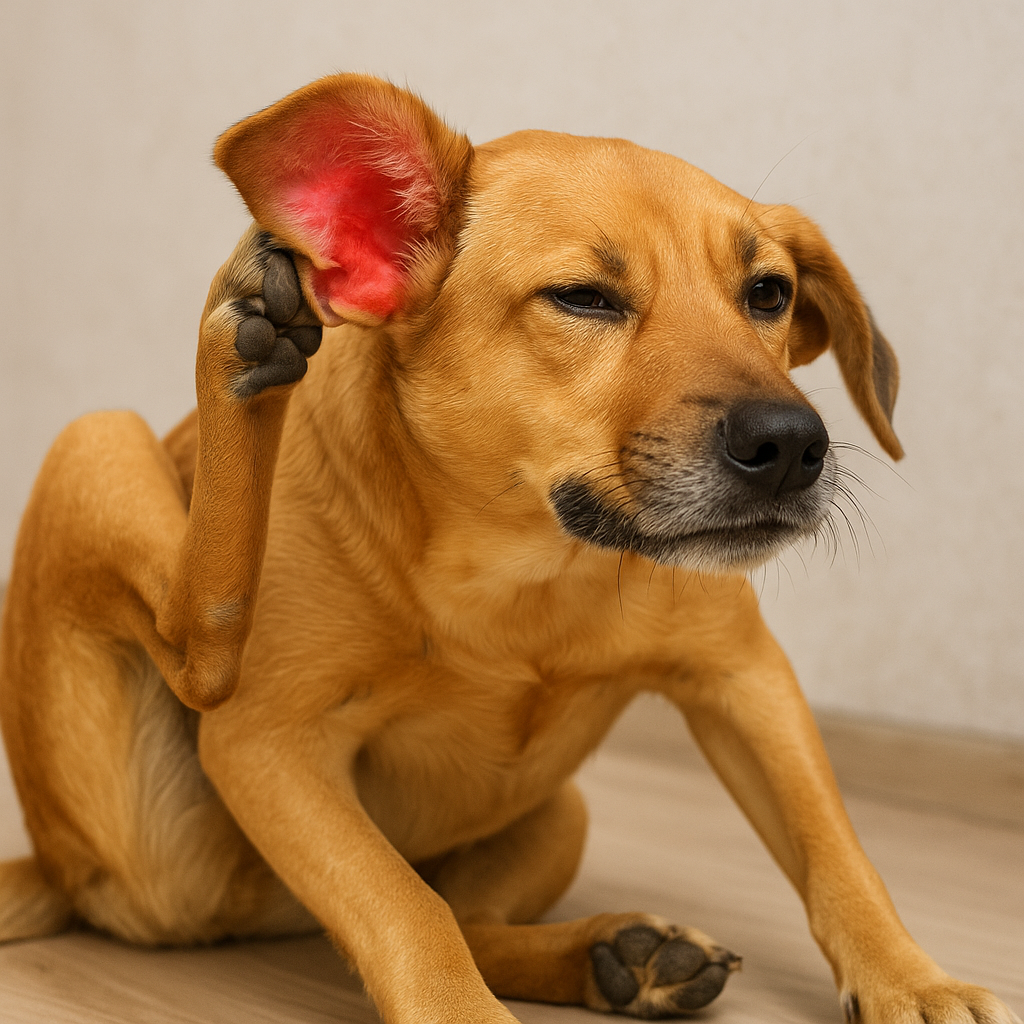
Dog yeast infections can look like other skin issues so recognizing the hallmark signs is key. If your dog is persistently itchy, smells musty, or has discoloured ear wax, yeast might be the culprit.
What to Watch For
- Red, itchy, or inflamed skin, especially around paws, ears, groin, and armpits
- Oily or greasy coat, often accompanied by dandruff or thickened skin
- Foul odour, often described as “corn chip” or “musty”
- Dark brown or black discharge in the ears (a classic sign of dog ear yeast)
- Hair loss, crusting, or thickened skin, especially in chronic cases
- Head shaking or ear scratching, common with ear infections
- Excessive paw licking or chewing, sometimes misdiagnosed as anxiety
These signs are often misattributed to seasonal allergies or bacterial infections. That’s why it’s important to get a veterinary diagnosis, especially if symptoms persist for more than a week or recur frequently.
Veterinary literature confirms that Malassezia yeast produces proteases and lipases that damage the skin barrier, leading to the inflammation and odour associated with yeast dermatitis in dogs (Frontiers in Microbiology, 2020).
In my own practice, one Bulldog presented with black, crusty ears and persistent head shaking. The diagnosis? A classic case of dog yeast infection caused by moisture buildup in deep ear canals quickly resolved with antifungal ear drops and dietary tweaks.
https://www.frontiersin.org/articles/10.3389/fcimb.2020.00079/full
Diagnosis & Veterinary Assessment for Dog Yeast Infections
Accurate diagnosis is essential because dog yeast infections often mimic allergies, bacterial skin infections, or even mange. Without proper testing, treatment can miss the mark or even worsen the issue.
How Vets Confirm Yeast
Veterinarians typically use one or more of the following:
- Cytology (ear or skin swab): A swab of affected skin or ear wax is examined under a microscope to identify yeast cells (Malassezia appears as “footprint” or “peanut-shaped” organisms).
- Tape impression or skin scraping: Adhesive tape is used to lift cells from the skin, which are stained and examined microscopically.
- Wood’s lamp: A special UV light used to rule out ringworm not useful for yeast, but helps narrow the diagnosis.
- Culture (rarely needed): Yeast grows fast in culture, but it’s usually diagnosed visually or microscopically.
- Assessment of underlying issues: Bloodwork or endocrine testing may be recommended if infections recur. Conditions like hypothyroidism or allergies often fuel yeast overgrowth in dogs.
A 2021 veterinary dermatology overview emphasized that cytology remains the gold standard for diagnosing canine yeast infections, especially when performed from both ears and skin sites (DVM360).
Why Testing Matters
Misdiagnosing dog yeast infections can lead to delayed treatment or inappropriate medications. For example, using antibiotics for a fungal infection may worsen the problem by further suppressing normal skin flora.
In my Ottawa clinic, I often swab itchy ears before prescribing anything many clients are surprised when what seemed like “just dirt” is packed with yeast cells.
Evidence-Based Treatments for Dog Yeast Infections
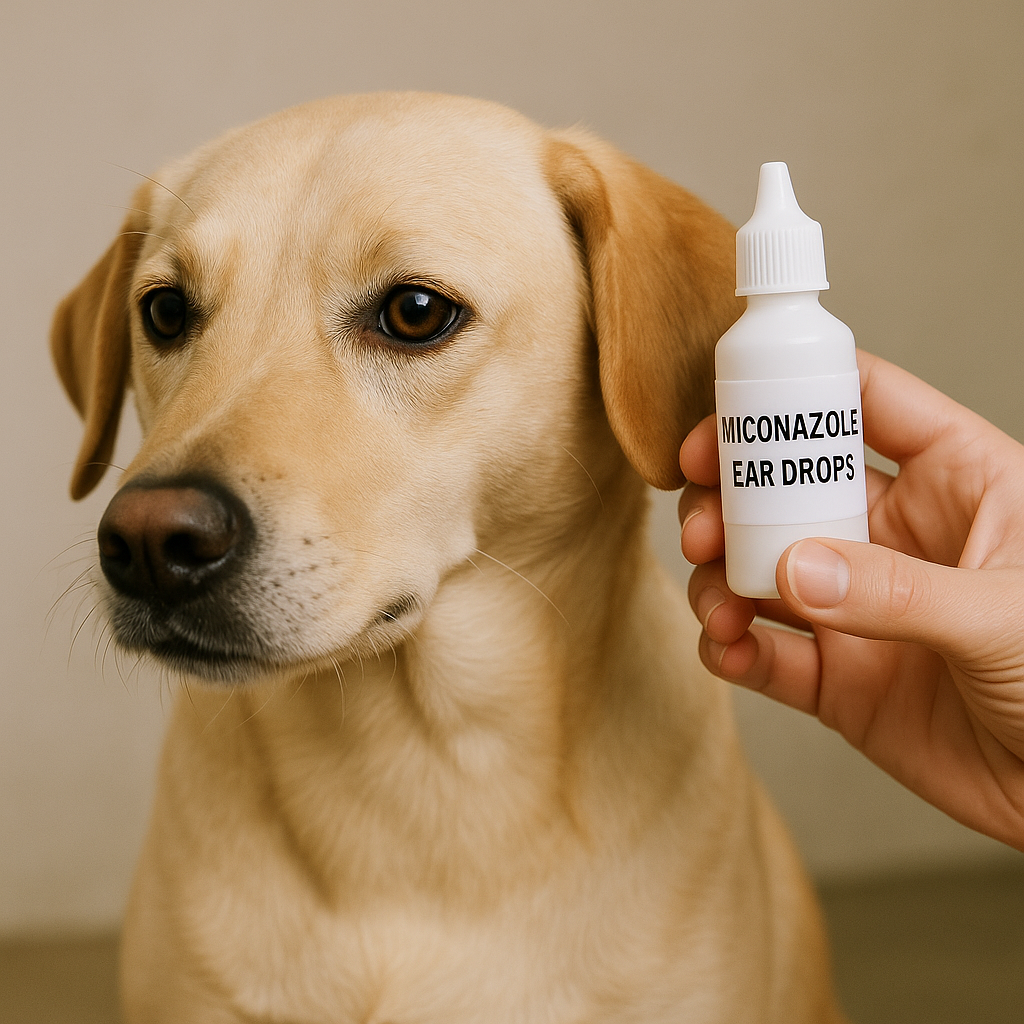
When properly diagnosed, dog yeast infections respond well to veterinary-directed antifungal therapy. Treatment varies depending on severity, location, and recurrence rate.
A. Topical Antifungals
For localized yeast dermatitis in dogs like mild ear infections or isolated skin patches topical products are often enough.
Common options include:
- Miconazole, clotrimazole, ketoconazole, or nystatin creams
- Medicated ear drops with antifungal + anti-inflammatory ingredients
- Chlorhexidine-miconazole shampoos, especially for skin fold infections
A double-blind study published in Veterinary Therapeutics found that 1–2% miconazole shampoos, used twice weekly, significantly reduced Malassezia counts and improved symptoms within 2–3 weeks (Veterinary Therapeutics, 2001).
I’ve seen this firsthand one Cocker Spaniel with chronic dog ear yeast showed remarkable improvement with daily miconazole drops and a weekly antifungal shampoo. His ears stayed clear for months after treatment.
B. Systemic Antifungal Therapy
If topical therapy fails or the infection is widespread, oral antifungals may be prescribed.
- Ketoconazole – effective but may cause liver enzyme elevation
- Itraconazole – better tissue penetration, fewer side effects
- Fluconazole – occasionally used for deep fungal infections
According to a systemic antifungal drug review in DVM360, itraconazole is preferred for chronic or deep dog yeast infections, especially when liver health is a concern (DVM360).
These medications are prescription-only and require bloodwork monitoring during extended use.
C. Adjunctive Therapies
To boost outcomes, adjunctive therapies are often combined with antifungals:
- Chlorhexidine-miconazole or ketoconazole shampoos, used 2–3 times weekly
- Leave-on conditioners or wipes with antifungal ingredients
- Anti-itch sprays or mild steroids, used short-term to reduce inflammation
A WAVD consensus report emphasizes that combining topical antifungals with antiseptic shampoos significantly reduces relapse in dog yeast infections (DVM360).
Natural & Supportive Remedies for Dog Yeast Infections
(Use these only under veterinary guidance)
While they’re never a substitute for proper vet care, natural options can support recovery and reduce recurrence of dog yeast infections especially in mild or early cases.
1. Diet Adjustments & Probiotics
Yeast feeds on carbohydrates. Reducing carb intake and switching to hypoallergenic, grain-free, or limited-ingredient diets can support dogs prone to yeast overgrowth.
- Look for single-protein diets (e.g. duck, salmon)
- Avoid high-starch fillers like corn, wheat, or potatoes
- Add probiotics like Lactobacillus acidophilus or Saccharomyces boulardii to restore gut-skin microbial balance
Recent evidence suggests probiotics can reduce recurrence in canine yeast infections by boosting immunity and restoring microbial diversity (Frontiers in Microbiology).
2. Diluted Apple Cider Vinegar (ACV) Rinse
A 50:50 water and ACV rinse (only on intact, non-irritated skin) may help restore acidic pH and inhibit yeast.
- Spray or dab onto paws or affected areas once daily
- Never apply to broken or inflamed skin it burns
Many dog owners have success using ACV as a weekly maintenance rinse, especially for paw infections.
3. Coconut Oil
Coconut oil contains caprylic acid and lauric acid, both of which show mild antifungal effects.
- Apply a small amount to clean, dry skin
- Use caution: it may trap moisture if overused
While not a cure, coconut oil may soothe itchy skin and act as a moisture barrier just be sure to patch-test first.
4. Omega-3 Fatty Acids
Adding fish oil or flaxseed oil may reduce inflammation and support skin healing in dogs with yeast dermatitis.
- Choose products with high EPA/DHA content
- Can be given as capsules or mixed into food
Skin barrier integrity improves with long-term omega supplementation, which can help prevent relapses.
Preventive Measures to Avoid Dog Yeast Infections
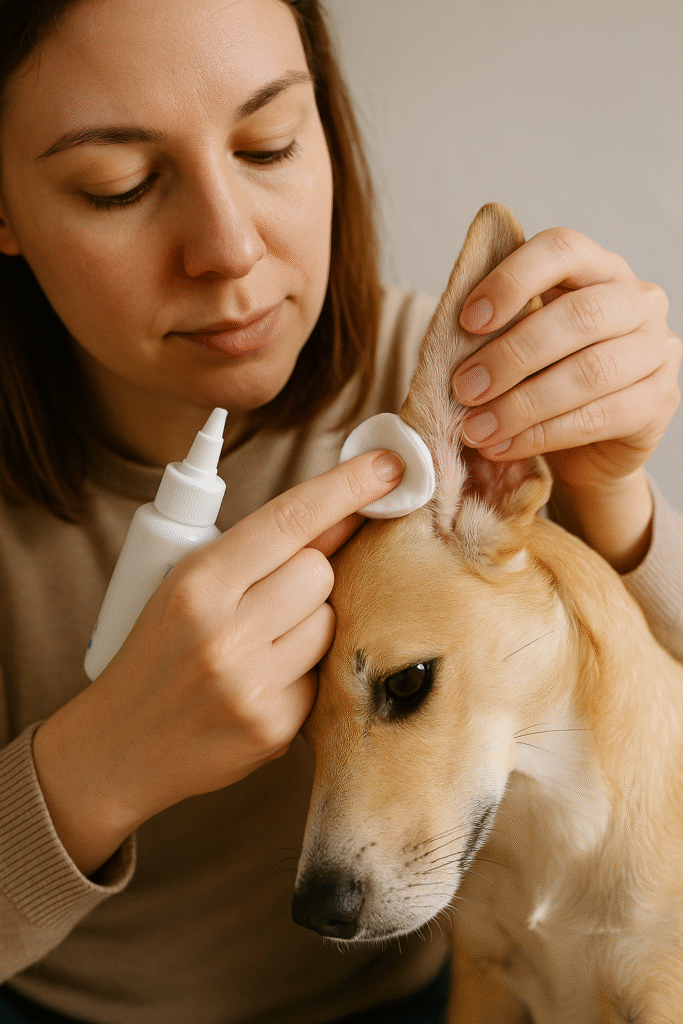
Recurring dog yeast infections can be frustrating for both dogs and their owners. But with proactive care, many flare-ups are avoidable. Prevention hinges on reducing moisture, improving hygiene, and managing underlying conditions.
1. Regular Hygiene & Grooming
- Dry ears and paws thoroughly after swimming or bathing
- Use vet-approved ear cleaners weekly for floppy-eared dogs
- Trim fur between paw pads to reduce moisture retention
- Bathe with antifungal or medicated shampoo every 2–3 weeks for at-risk dogs
I always remind clients: don’t over-bathe your dog, but don’t ignore yeasty smells either. Clean folds and ears regularly—before yeast takes hold.
2. Diet & Allergy Management
- Identify food triggers through elimination diet trials
- Avoid high-carb treats or low-quality kibble
- Introduce limited-ingredient diets or hydrolyzed proteins for allergy-prone dogs
Dogs with food sensitivities often present with chronic ear infections or paw licking classic signs of yeast overgrowth in dogs.
3. Weight & Health Monitoring
- Obesity contributes to skin folds and chronic inflammation
- Dogs with endocrine issues (e.g. hypothyroidism) need regular testing
- Keep up with annual wellness checks to catch risk factors early
A Bichon Frise patient of mine stopped having ear yeast infections entirely after we diagnosed and treated her low thyroid levels.
4. Monthly Maintenance Treatments
For dogs with chronic dog yeast infections, long-term management may include:
- Antifungal shampoo baths monthly or as needed
- Ear drops or wipes on a routine schedule
- Ongoing dietary support (e.g. omega-3s, probiotics)
Proactive care prevents flare-ups and reduces the need for frequent medications.
Real-World Case Scenarios of Dog Yeast Infections
These clinical examples reflect common presentations of dog yeast infections I’ve encountered in practice. They highlight how individualized treatment and lifestyle changes can make a big difference.
Case 1: Otitis in a Labrador Retriever
Patient: 5-year-old neutered male
History: Recurrent head shaking, dark ear discharge, musty smell
Diagnosis: Cytology revealed Malassezia overgrowth in both ears
Treatment: Twice-daily miconazole–chlorhexidine ear drops for 10 days; switched to a limited-ingredient fish-based diet; added omega-3s
Outcome: Symptoms resolved completely within 2 weeks; no recurrence after 3 months with weekly maintenance cleanings.
This case shows how combining antifungal treatment for dogs with dietary and hygiene changes can control dog ear yeast effectively.
Case 2: Skin Fold Yeast in a Bulldog
Patient: 4-year-old female English Bulldog
Symptoms: Red, itchy facial folds with a strong odour; oily residue and constant rubbing
Treatment: 2x/week chlorhexidine-miconazole baths, daily diluted ACV wipe in folds, probiotic added to food
Outcome: Dramatic improvement in 10 days; owner continued a weekly fold-cleaning routine to prevent recurrence.
Bulldogs and other wrinkly breeds are high-risk for yeast dermatitis in dogs, especially in facial folds.
When to See a Vet for Dog Yeast Infections
While some mild dog yeast infections may improve with at-home care, others require professional attention especially if symptoms persist or worsen.
Seek veterinary care if:
- Symptoms last longer than 7–10 days, even with antifungal or natural treatment
- Your dog has recurring yeast infections (e.g. every few months)
- There’s thick, crusty discharge, bleeding, or signs of secondary infection
- Your dog shows systemic signs like fever, lethargy, or appetite loss
- You’re unsure whether it’s yeast, bacteria, or something else
- Your dog has underlying conditions like allergies or hypothyroidism
In clinic, I often see dogs that were treated at home with over-the-counter creams only for the infection to return worse a few weeks later. Without diagnosing the root cause (like a food allergy or hormonal imbalance), the cycle continues.
Veterinarians can use cytology, cultures, and lab testing to confirm canine yeast infections and tailor a plan specific to your dog’s needs. This ensures faster recovery and reduces the risk of complications or relapses.
Frequently Asked Questions About Dog Yeast Infections
1. What causes dog yeast infections to flare up?
Dog yeast infections often flare due to excess moisture (from swimming or bathing), food allergies, antibiotic use, or underlying conditions like hypothyroidism. Yeast thrives in warm, damp environments especially ears and skin folds.
2. Can I treat a dog yeast infection at home?
Mild cases may improve with vet-approved antifungal shampoos or diluted apple cider vinegar rinses. However, chronic or severe yeast dermatitis in dogs needs veterinary diagnosis and treatment. Never use human antifungals without consulting your vet.
3. How do I know if it’s a yeast infection or something else?
Look for greasy skin, musty odour, dark ear discharge, or constant licking. That said, these signs overlap with allergies or bacterial infections. Vets use cytology to confirm canine yeast infections under the microscope.
4. Are some dog breeds more prone to yeast infections?
Yes. Breeds with floppy ears (e.g. Cocker Spaniels), skin folds (Bulldogs, Pugs), or allergies (Labradors, German Shepherds) are more likely to develop dog yeast infections especially in hot, humid climates.
5. Can a poor diet cause yeast infections in dogs?
A high-carb or allergen-rich diet can disrupt the gut-skin axis, creating conditions for yeast overgrowth in dogs. Switching to a hypoallergenic or grain-free diet can often reduce flare-ups, especially in sensitive breeds.
6. Is coconut oil safe for dog yeast infections?
Used sparingly, coconut oil’s natural antifungal properties can support recovery but only on intact skin and under vet guidance. It’s not a cure, but may help manage dog yeast infections when combined with other treatments.
Conclusion: You Can Manage and Prevent Dog Yeast Infections
Dog yeast infections are frustrating but highly manageable when addressed early and holistically. From itchy ears and paws to greasy, smelly skin, yeast thrives where conditions allow but with proper diagnosis, targeted treatment, and supportive care, your dog can heal and thrive.
Whether you’re using vet-prescribed antifungals, fine-tuning your dog’s diet, or incorporating natural remedies like diluted apple cider vinegar or probiotics, the key is consistency and prevention. In my Ottawa practice, I’ve seen firsthand how a thoughtful, layered approach transforms chronic cases into long-term relief stories.
Always consult your veterinarian before starting treatment especially if symptoms persist beyond 10 days, recur often, or appear alongside systemic illness. Every dog is different, and what works for one may not work for another.
Stay proactive. Stay informed. And remember: when it comes to dog yeast infections, early action is the best medicine.

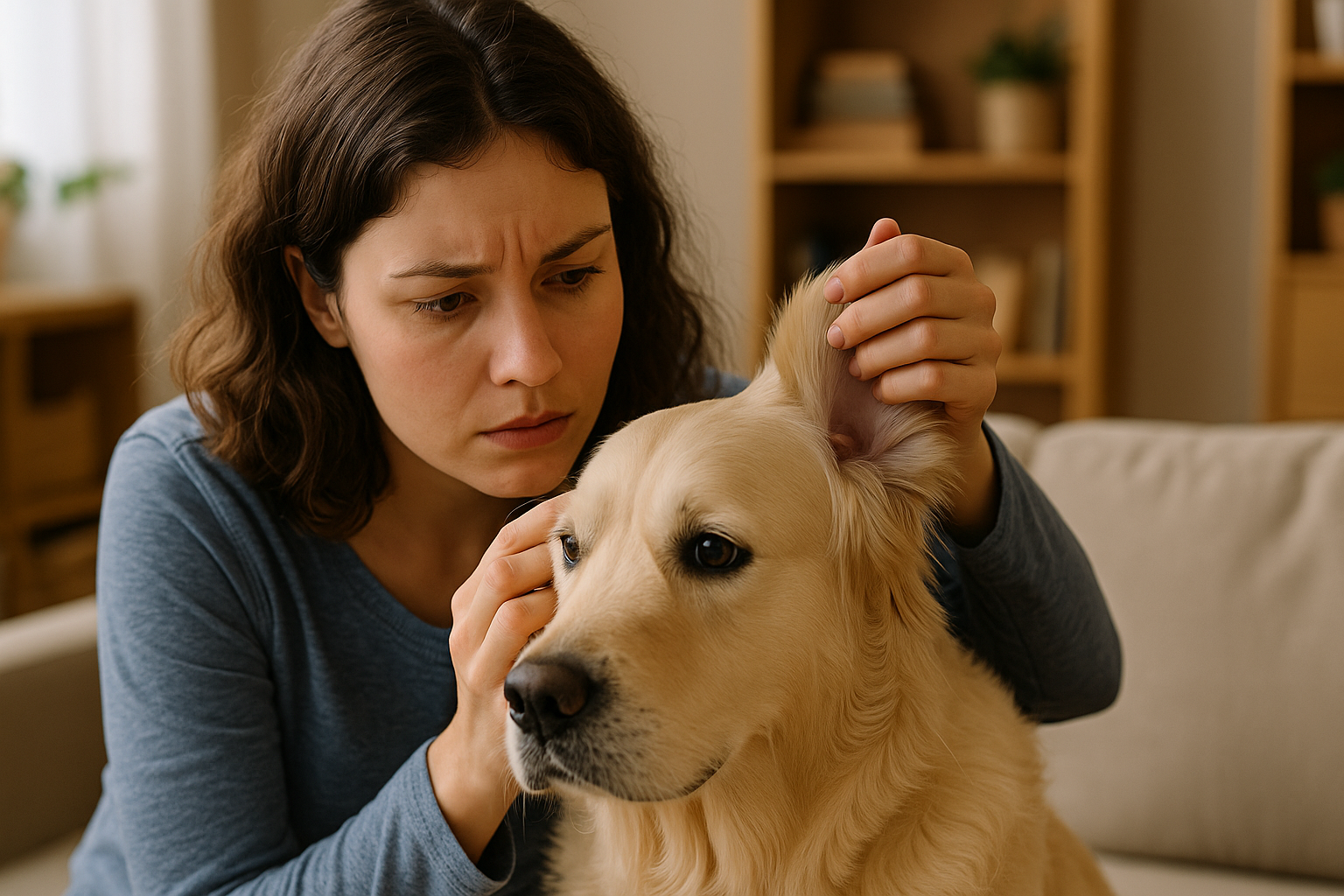
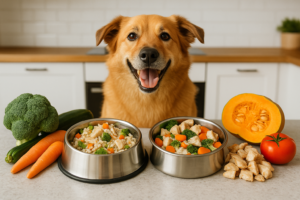
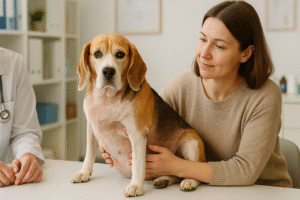
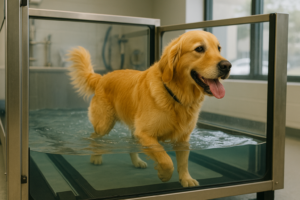
Pingback: Best Omega‑3 Supplements for Dog Coat Health (2025 Vet Guide)